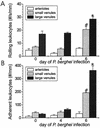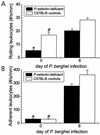P-selectin contributes to severe experimental malaria but is not required for leukocyte adhesion to brain microvasculature
- PMID: 12654808
- PMCID: PMC152027
- DOI: 10.1128/IAI.71.4.1911-1918.2003
P-selectin contributes to severe experimental malaria but is not required for leukocyte adhesion to brain microvasculature
Abstract
Plasmodium berghei-infected mice, a well-recognized model of experimental cerebral malaria (ECM), exhibit many of the hallmarks of a systemic inflammatory response, with organ damage in brain, lung, and kidneys. Identification of the molecules mediating pathogenesis of the inflammatory response, such as leukocyte adhesion, may lead to new therapies. Indeed, mice lacking the cell adhesion molecule P-selectin were significantly (P = 0.005) protected from death due to P. berghei malaria compared with C57BL/6 controls despite similar parasitemia (P = 0.6) being found in both groups of mice. P-selectin levels assessed by the quantitative dual radiolabeled monoclonal antibody technique increased significantly (P < 0.05) in several organs in C57BL/6 mice infected with P. berghei, supporting the concept of a systemic inflammatory response mediating malarial pathogenesis. Intravital microscopic analysis of the brain microvasculature demonstrated significant (P < 0.001) leukocyte rolling and adhesion in brain venules of P. berghei-infected mice compared with those found in uninfected controls. The maximum leukocyte adhesion occurred on day 6 of P. berghei infection, when the mice become moribund and exhibit marked vascular leakage into the brain, lung, and heart. However, P-selectin levels were significantly (P < 0.005) increased in brain, lung, and kidneys during P. berghei malaria in ECM-resistant BALB/c mice compared with those found in uninfected BALB/c controls, indicating that increased P-selectin alone is not sufficient to mediate malarial pathogenesis. Leukocyte adhesion to brain microvessels of P-selectin-deficient mice with P. berghei malaria was similar to that observed in control mice. Collectively, these results indicate that P-selectin is important for the development of malarial pathogenesis but is not required for leukocyte adhesion in brain.
Figures





Similar articles
-
Exogenous nitric oxide decreases brain vascular inflammation, leakage and venular resistance during Plasmodium berghei ANKA infection in mice.J Neuroinflammation. 2011 Jun 7;8:66. doi: 10.1186/1742-2094-8-66. J Neuroinflammation. 2011. PMID: 21649904 Free PMC article.
-
Intercellular adhesion molecule 1 is important for the development of severe experimental malaria but is not required for leukocyte adhesion in the brain.J Investig Med. 2003 May;51(3):128-40. doi: 10.1136/jim-51-03-15. J Investig Med. 2003. PMID: 12769195
-
Inhibition of platelet adherence to brain microvasculature protects against severe Plasmodium berghei malaria.Infect Immun. 2003 Nov;71(11):6553-61. doi: 10.1128/IAI.71.11.6553-6561.2003. Infect Immun. 2003. PMID: 14573677 Free PMC article.
-
Contrasting pediatric and adult cerebral malaria: the role of the endothelial barrier.Virulence. 2013 Aug 15;4(6):543-55. doi: 10.4161/viru.25949. Epub 2013 Aug 2. Virulence. 2013. PMID: 23924893 Free PMC article. Review.
-
Experimental Models to Study the Pathogenesis of Malaria-Associated Acute Respiratory Distress Syndrome.Front Cell Infect Microbiol. 2022 May 23;12:899581. doi: 10.3389/fcimb.2022.899581. eCollection 2022. Front Cell Infect Microbiol. 2022. PMID: 35677654 Free PMC article. Review.
Cited by
-
CXCL10 stabilizes T cell-brain endothelial cell adhesion leading to the induction of cerebral malaria.JCI Insight. 2018 Apr 19;3(8):e98911. doi: 10.1172/jci.insight.98911. eCollection 2018 Apr 19. JCI Insight. 2018. PMID: 29669942 Free PMC article.
-
The role of platelets in the pathogenesis of cerebral malaria.Cell Mol Life Sci. 2010 Feb;67(4):557-68. doi: 10.1007/s00018-009-0211-3. Epub 2009 Nov 29. Cell Mol Life Sci. 2010. PMID: 20091081 Free PMC article. Review.
-
Cytomegalovirus reactivation and acute and chronic complications in children with cerebral malaria: a prospective cohort study.Malar J. 2025 Feb 17;24(1):48. doi: 10.1186/s12936-025-05293-x. Malar J. 2025. PMID: 39962580 Free PMC article.
-
Pathogenic role of P-selectin in experimental cerebral malaria: importance of the endothelial compartment.Am J Pathol. 2004 Mar;164(3):781-6. doi: 10.1016/S0002-9440(10)63166-5. Am J Pathol. 2004. PMID: 14982832 Free PMC article.
-
Exogenous nitric oxide decreases brain vascular inflammation, leakage and venular resistance during Plasmodium berghei ANKA infection in mice.J Neuroinflammation. 2011 Jun 7;8:66. doi: 10.1186/1742-2094-8-66. J Neuroinflammation. 2011. PMID: 21649904 Free PMC article.
References
-
- Amani, V., A. M. Vigario, E. Belnoue, M. Marussig, L. Fonseca, D. Mazier, and L. Renia. 2000. Involvement of IFN-gamma receptor-medicated signaling in pathology and anti-malarial immunity induced by Plasmodium berghei infection. Eur. J. Immunol. 30:1646-1655. - PubMed
-
- Bienvenu, K., and D. N. Granger. 1993. Molecular determinants of shear rate-dependent leukocyte adhesion in postcapillary venules. Am. J. Physiol. 264:H1504-H1508. - PubMed
-
- Campbell, J. J., J. Hedrick, A. Zlotnik, M. A. Siani, D. A. Thompson, and E. C. Butcher. 1998. Chemokines and the arrest of lymphocytes rolling under flow conditions. Science 279:381-384. - PubMed
-
- Clark, I. A., and L. Schofield. 2000. Pathogenesis of malaria. Parasitol. Today 16:451-454. - PubMed
Publication types
MeSH terms
Substances
Grants and funding
LinkOut - more resources
Full Text Sources

